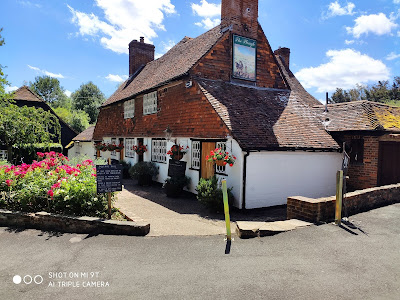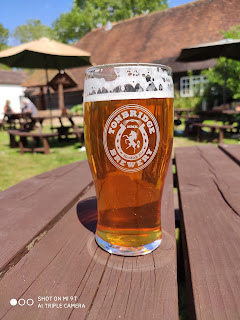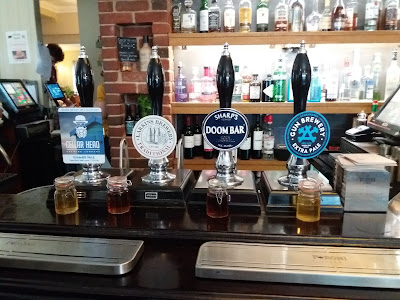The Nelson Arms, tucked away in the backstreets behind the station, seemed the obvious candidate. The Nelson picked up the prestigious Branch Pub of the Year award, from West Kent CAMRA, just a week or so prior to the start of lockdown, so that was a good enough reason on its own for a visit.
I’d been calling in at the Nelson these past three months, in order to collect containers of cask ale to drink at home, so had been taking a keen interest on how their plans for reopening were progressing. A visit there was high on my list, and it still is, but given the fine weather we’ve enjoyed today, I fancied something a little more taxing. A pub visit that included a walk fitted the bill, which is where the Plough at Leigh Powder Mills came in.I’d already checked their website and liked what I saw regarding their Covid-19 response. To me it seemed sensible without being over the top. The fact that I fancied a pint in a pub garden, was another reason for choosing the Plough as it has one of the largest gardens in the area.
The Plough is surprisingly easy to get to from Tonbridge, as the footpath which leads across the Sportsground provides a far more direct route than going by road. It also proved much quicker than what I remembered. It must be five or six years since I last walked that way, but the route still seems just as popular with walkers and cyclists as it did back then.The walk wasn’t quite as far as I thought. I clocked it at three miles, door to door, and the outward journey took just over an hour. Tonbridge Sportsground seemed as popular as ever, with people of all ages out enjoying the sunshine plus taking the opportunity to spread themselves out. I took a diagonal route across this large, flat grassy area towards the underpass beneath the main rail line to London. The path then continues through a wooded area, following the course of the River Medway.
It then splits, with the route to the left leading to Haysden Country Park, whilst the right-hand path heads off towards Leigh Power Mills. The suffix, "Powder Mills" refers to the manufacture of gun-powder, which was carried out there, on a substantial site, until the mid 1930’s. The site was chosen because of its proximity to the River Medway, plus the presence of several small streams. These were used to power the mills which processed the gun-powder, until the advent of steam power.In recent times, part of the Powder Mills site was home to pharmaceutical giant Glaxo Smith Kline. Around 300 people were employed there until the plant closed in 2010. A development of mixed housing stock now occupies the site, but I’m pleased to report that the area of woodland to the right of the former works, has been retained, and the footpath running alongside it has been upgraded.
Upon reaching the road which runs along to Leigh village, I turned right and headed down a slight hill. The Plough is just a short distance ahead, but he first thing one notices is the substantial barn, next to the pub, which is used for weddings and other similar functions. I made my way towards the pub, approaching with more than a little trepidation.I needn’t have been concerned, as I noticed, whilst passing the garden, that there were plenty of free tables. I stopped, as instructed, at the sign adjacent to the entrance and waited, again as instructed. A member of staff came out to greet me, and after taking a couple of contact details – name, plus mobile phone number, I was allowed inside.
It was explained to me that a one-way system operated inside the pub and that all food and drink could be ordered from the outside bar; apart from the real ale. Seeing as a pint of cask was what I wanted, I was informed I should order my drink from the bar, as normal and then either find a seat inside – there were quite a few vacant tables, or make my way through to the garden. There was a large Perspex screen isolating staff behind the bar, apart from a cut-out to enable payment and receipt of one’s drink.The cask choice was three offerings from Tonbridge Brewery, so I opted for the Golden Rule, a 3.5% light and refreshing, golden ale. I carefully carried my pint through the length of the pub and then down the steps into the substantial garden. I found a vacant table and sat down to enjoy my first pint of cask ale since the visit I made on 6th March to Burton-on-Trent, with members of the Beer & Pub’s Forum.
Boy did it taste good, being cool, clear and well-conditioned. Had I been scoring I would have rated it as at least 3.5 NBSS. The beer was so good that I was tempted to have another; the only thing preventing me was my promise to pick up some food items from Waitrose on the way back. The store’s 4pm closing time would have meant a fast walk back, whereas I am someone who prefers strolling along at a much more leisurely pace.The pub garden had a good sprinkling of customers without being packed. It was good to see families and groups of friends enjoying a few drinks along with each other’s company, after these long months of confinement. What’s more, it was being done in a safe and dare I use the term, socially distanced way. There was hand-sanitiser available at the entrance and also at the exit – which is now down the steps, next to the garden.
The Plough’s management team had obviously worked hard to achieve this, and I applaud their efforts. I felt relaxed and totally at ease, and I know I would have felt the same had I decided to enjoy my beer inside the pub instead. Upon my return, Mrs PBT’s was relieved when I described the set-up. Being familiar with the pub she should have known better, but she had been a little bit concerned when I set off on my visit.I would like to send the same message to all the naysayers, doom-mongers and anyone else who predicted that pubs re-opening would mean the end of civilisation as we know it whilst the world is engulfed in a plague of biblical proportions.
Pub owners, licensees and their staff have pulled out all the stops to make this work. The least we can do is show them our appreciation by turning up and supporting their efforts. There is quite lot more I could write on this subject, but bloggers such as Pub Curmudgeon, Tandleman, retiredmartin and Beer Viking have already covered the seeming reluctance of many punters to return to the pub. Check out what they have to say on the subject, by clicking their links in the left-hand side bar.This article is intended to make up for the shortcomings of the previous one, which was posted, in my excitement, from the pub garden, after having been hastily composed on my Smart Phone.






















